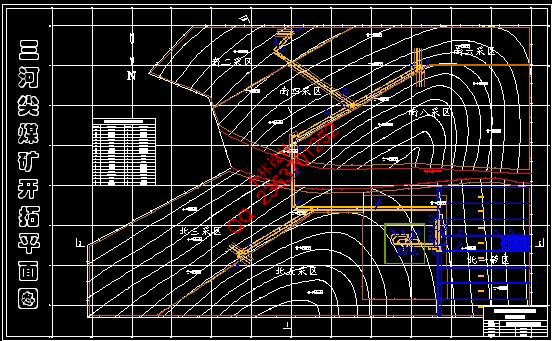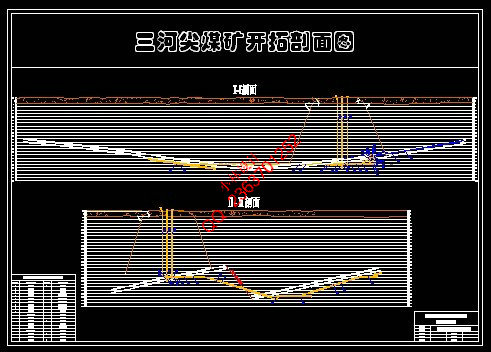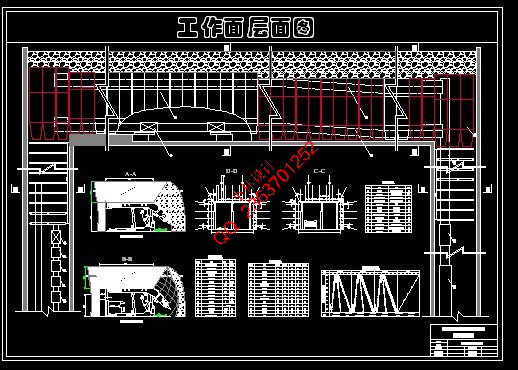|
设计简介 |
设计描述:
文档包括:
Word版说明书1份,共148页,约78000字
外文翻译一份
CAD版本图纸,共5张
摘 要
本设计包括三个部分:“三河尖矿2.4 Mt/a新井设计”、“声发射监测冲击矿压技术及其应用”专题论文和“A study on coal mining under large reservoir areas”翻译。
(1)三河尖矿2.4 Mt/a新井设计
三河尖煤矿位于江苏省徐州市北面,交通便利。井田走向(东西)长约4.65 km,倾向(南北)长约3.65 km,井田总面积为16.99 km2。主采煤层为7号煤、9号煤,平均倾角为13°,煤层平均总厚为15.0 m。井田地质条件较为简单。矿井正常涌水量为60 m3/h,最大涌水量为120 m3/h,涌水量不大。矿井绝对瓦斯涌出量为15 m3/min,相对瓦斯涌出量为3.024 m3/t,为低瓦斯矿井。井田工业储量为34603万t,矿井可采储量22235万t。
设计矿井生产能力为2.4 Mt/a,服务年限为66.18 a。选择矿井年工作日为330 d,工作制度为“四六”制。
井田设计为立井两水平开拓。共分6采区、1带区,采用前进式开拓方式。第一水平分2采区、1带区,服务年限为32.46年。主井采用一对16吨箕斗提升,副井采用一对1.5吨矿车双层四车罐笼提升,大巷采用胶带运输机运煤,辅助运输采用矿车。矿井通风方式为中央并列式通风。设计一个采区保证矿井生产能力。
矿井首采区为北一带区。带区内共划分为8个条带,条带宽为200m,长为1040 m。
设计工作面为7104工作面。采用放顶煤开采,端部斜切进刀,工作面采用液压支架支护,两巷超前支护采用单体支柱。工作面采用U型通风方式通风。
一般部分共包括10章:1.矿区概述及井田地质特征;2.井田境界和储量;3.矿井工作制度及设计生产能力、服务年限;4.井田开拓;5.准备方式-带区巷道布置;6.采煤方法;7.井下运输;8.矿井提升;9.矿井通风与安全;10.矿井基本技术经济指标。
(2)专题论文“声发射监测冲击矿压技术及其应用”
该论文主要研究了声发射法监测冲击矿压的原理,并分析了华亭矿的声发射监测数据。
(3)翻译文章“A study on coal mining under large reservoir areas”
译文“大型水库下采煤的研究”主要讲述了越城水库下沈家庄矿安全开采的内容。
关键词:矿井设计,立井开拓,准备,采煤,冲击矿压
ABSTRACT
This design includes of three parts: “the new design of 2.4Mt Sanhejian Mine”, the special subject part of “Acoustic emission monitoring burst technology and its applications” and the translation part of “A study on coal mining under large reservoir areas”.
( 1 ) the new design of 2.4 Mt Sanhejian Mine
Sanhejian Mine is situated in the North of Xuzhou city Jiangsu province. The traffic of road and railway is very convenient to the mine. The run of the minefield is 4.65 km ,the width is about 3.65 km,well farmland total area is 16.99 km2.No 7and No 9 are the main coal seams, and the average dip angle is 13 degree. The average thickness of the seams is about 15.0m in all and the geology of the coalfield is simple. The normal water flow of the mine is 60 m3 per hour and the max is 120 m3 per hour. The absolute outflow of gas is 15.362 m3/min and the relative gas emissions 3.042 m3/t as a low gas mine. The industrial reserve of the minefield is 346.03 million tons and the recoverable reserve is 222.35 million tons.
The designed productive capacity is 2.4 Mt/a, and the service life of the mine is 66.18 years. “Four-six” as the working system is used in the Sanhejian Mine. It produced 330d/a.
Sanhejian mine is developed by vertical shaft with two levels. The whole mine which is developed forward contains 6 panels and 1 band. The first level is divided into 2 panels and 1band, with the service life of 32.46 years. The main shaft is hoisted with double skips of 16 tons and the auxiliary shaft is hoisted with double cages of 1.5 tons of double four-car. In the main haulage way, the coal is transported by belt conveyer, and the mine car is used as the auxiliary transportation equipment in the main rail-tunnel. The ventilation mode of the mine is center to center. The mine productive capacity is guaranteed by one mining area.
The first mining area is N1 band which is cut into 8 strips of which the width is 200 m and the length is 1040m.
The designed coalface is 7104. With top coal caving and end miter feeding, the working face is supported with hydraulic support and the double advance lanes are supported with single pillar. The ventilation mode of the coalface is U-type.
The general part includes ten chapters: 1.An outline of the mine and the geology of the coalfield; 2.Boundary and the reserve of mine; 3.The service life and working system of mine; 4. The development engineering of coalfield; 5.The layout of mining area; 6. Coal mining method; 7. Underground transportation; 8. Mine hoisting; 9.Mine ventilation and safety; 10.The basic economic and technical index.
( 2 )The special part “Acoustic emission monitoring burst technology and its application”
The thesis mainly study the principle of the acoustic emission method to monitor burst and analyzes Huating Mine AE monitoring data.
( 3 )The translation part of “A study on coal mining under large reservoir areas”
The translation part mainly studys on how to exploit the Shenjiazhuang Mine under Yuecheng reservoir safely.
Keywords:mine design, vertical shaft development, preparation, coal mining, burst
目 录
一般部分
1 矿区概述及井田地质特征 1
1.1矿区概述 1
1.1.1交通地理位置 1
1.1.2地形地势 1
1.1.3河流、湖泊、地表水系 1
1.1.4气候条件 1
1.1.5自然地震 3
1.1.6电力供应 3
1.2井田地质特征 3
1.2.1地层 3
1.2.2地质构造 5
1.2.3水文地质 5
1.2.4其他有益矿产 6
1.3煤层特征 6
1.3.1可采煤层 6
1.3.2煤质 7
1.3.3瓦斯 7
1.3.4煤尘及煤的自燃倾向 8
1.3.5地温 8
1.3.6冲击地压 8
2 井田境界和储量 9
2.1井田范围 9
2.1.1井田边界 9
2.1.2开采界限 9
2.2矿井工业储量 10
2.2.1储量计算的步骤: 10
2.2.2井田地质勘探 10
2.2.3工业储量计算 10
2.3矿井可采储量 12
2.3.1安全煤柱 12
2.3.2矿井永久保护煤柱损失量 13
2.3.3矿井可采储量 14
3 矿井工作制度及设计生产能力、服务年限 15
3.1矿井工作制度 15
3.2矿井设计能力及服务年限 15
3.2.1确定依据 15
3.2.2矿井设计生产能力 15
3.2.3矿井服务年限 15
3.2.4井型校核 15
4 井田开拓 17
4.1井田开拓的基本问题 17
4.1.1确定井筒形式、数目、位置及坐标 17
4.1.2工业广场位置、形状的确定 19
4.1.3开采水平 19
4.1.4大巷布置 20
4.2方案比较 20
4.2.1开拓方案的提出及粗略比较 20
4.2.2经济比较 26
4.3矿井基本巷道 29
4.3.1井筒 29
4.3.2井底车场 33
4.3.3主要开拓巷道 34
5 准备方式—带区巷道布置 37
5.1煤层地质特征 37
5.1.1带区煤层特征 37
5.1.2地质构造 37
5.1.3顶底板特性 37
5.1.4水文地质 38
5.1.5地表情况 38
5.2带区巷道布置及生产系统 38
5.2.1带区位置及范围 38
5.2.2带区内分带的划分 38
5.2.3带区巷道布置 38
5.2.4工作面接替顺序 40
5.2.5带区主要生产系统 40
5.2.6带区巷道掘进 40
5.2.7带区生产能力及采出率 41
5.3带区车场选型设计 42
5.3.1确定车场形式 42
5.3.2带区主要硐室布置 43
6 采煤方法 44
6.1采煤工艺方式 44
6.1.1带区煤层特征及地质条件 44
6.1.2确定采煤工艺方式 44
6.1.3回采工作面参数 45
6.1.4回采工作面破煤与装煤方式 46
6.1.5回采工作面运煤方式 47
6.1.6回采工作面支护方式 47
6.1.7采放比、放煤步距、放煤方式 50
6.1.8各工艺过程注意事项 51
6.1.9回采工作面正规循环作业 52
6.2回采巷道布置 54
6.2.1回采巷道布置方式 54
6.2.2回采巷道参数 55
7 井下运输 57
7.1概述 57
7.1.1运输设计的原始条件与数据 57
7.1.2运输距离与货载量 57
7.1.3矿井运输系统 57
7.2带区运输设备选择 58
7.2.1设备选型原则 58
7.2.2带区煤炭运输设备选型 58
7.2.3带区辅助运输设备选型 60
7.3大巷运输设备选择 62
7.3.1运输大巷设备选型 62
7.3.2辅助运输大巷设备选型 62
8 矿井提升 64
8.1概述 64
8.2主副井提升 64
8.2.1主井提升 64
8.2.2副井提升 66
9 矿井通风及安全技术 67
9.1矿井通风系统的选择 67
9.1.1矿井概况 67
9.1.2矿井通风系统的基本要求 67
9.1.3矿井通风方式的确定 67
9.1.4矿井通风方法确定 68
9.1.5带区通风基本要求 69
9.1.6带区通风系统 69
9.1.7工作面通风方式及风向 69
9.1.8矿井通风容易与困难时期确定 70
9.2带区及全矿所需风量 73
9.2.1采煤工作面实际需风量 73
9.2.2备用工作面需风量 74
9.2.3掘进工作面需风量 74
9.2.4硐室需风量 76
9.2.5其它巷道需风量 76
9.2.6矿井总需风量 76
9.2.7风量分配 77
9.3全矿通风阻力的计算 78
9.3.1矿井通风总阻力计算原则 79
9.3.2矿井最大最小阻力路线 79
9.3.3矿井通风阻力计算 79
9.3.4矿井通风总阻力 80
9.3.5总等积孔 81
9.4选择矿井通风设备 81
9.4.1选择主扇 81
9.4.2电动机选型 86
9.5防止特殊灾害的安全措施 86
9.5.1瓦斯管理措施 86
9.5.2煤尘的防治 86
9.5.3预防井下火灾的措施 87
9.5.4防水措施 87
10 设计矿井基本技术经济指标 88
参考文献 89
专题部分
声发射监测冲击矿压技术及其应用实例 90
1引言 90
2煤矿动压介绍 90
2.1冲击矿压现象形成特点及分类 90
2.1.1冲击矿压现象 90
2.1.2冲击矿压的特点 90
2.1.3冲击矿压分类 91
2.1.4冲击矿压和矿山震动对环境的影响 91
2.2冲击矿压发生机理 92
2.2.1冲击矿压影响因素 92
2.2.2冲击矿压发生的机理及判据 93
3声发射技术 94
3.1声发射的物理基础及特点 94
3.1.1声发射的物理基础 94
3.1.2岩石中的声发射源 94
3.1.3岩石声发射信号的形状与频率频谱 94
3.2岩石变形过程中的声发射 95
3.2.1载荷的增长对岩石声发射的影响 95
3.2.2稳定载荷下声发射频度的变化 97
3.2.3循环载荷下声发射频度的变化 98
3.2.4温度对声发射的影响 98
3.3声发射的测量与观测 99
3.3.1固定式连续声发射监测探头的布置 99
3.3.2流动声发射监测探头的布置 99
3.4冲击矿压动力危险声发射预测 100
3.4.1站式连续监测 100
3.4.2危险性监测的基础 100
3.4.3冲击矿压危险性评价指标的确定 101
3.4.4冲击矿压危险状态的分类 101
3.4.5冲击矿压危险状态的预测 102
3.5激发声发射法监测 104
4应用实例 105
4.1ARES-5/E地音监测系统的监测数据分析 105
4.2ARES-5/E地音监测系统实例分析 107
4.3小结 110
5结论 111
参考文献 112
翻译部分
英文原文 114
中文译文 125
致 谢 133
|










